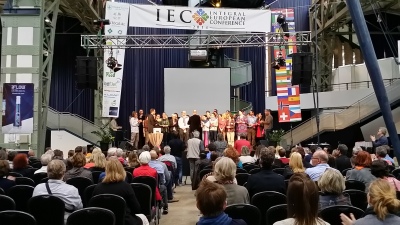Three Learning Lhabitats have explored the 4 Voices of the City in the United States, Canada and Europe in the last year. This blog considers how comparing the results from Learning Lhabitats at the Integral Theory Conference 2013, Federation of Canadian Municipalities Sustainability Conference 2014 and Integral Europe Conference 2014 serves as Gateways to our Planet of Cities, that open wider understanding of the role of the Citizen Voice in the city. (Integral City has characterized Citizens as the Producers and Conformity Enforcers of the City.)

IEC 2014: Citizens from Many Cultures
Profiles of the Co-Researchers
In collecting this data, it is interesting to note the profile of the participants in each conference. The Integral Theory Conference 2013, located in San Francisco, USA, attracted thinkers and theorists with a major interest and focus on integral points of view – a group that were heavily weighted in the Upper Left /Consciousness Quadrant of the Integral Model. At the same time, this group self-identified as being strongly biased in favour of Innovators and Business or Diversity Generators.
The Federation of Canadian Municipality Sustainability Conference 2014, located in Prince Edward Island, Canada, attracted Mayors, City Managers and Civic Leaders with an interest in sustainability and action orientation. So from an integral perspective this group were heavily weighted in the Upper Right/Action and Lower Right/Systems Quadrants of the Integral Model. This group by definition were Civic Managers or Resource Allocators.
Finally the Integral Europe Conference 2014, located in Budapest, Hungary, attracted a diversity of cultures and actors from across Europe (with smaller representation from other non-European nations) who were heavily weighted in the Lower Left/ Cultural Quadrant of the Integral Model. This group had a strong predisposition to be Inner Judges from Civil Society (with a strong showing from Business as well.)
These three groups give us an in interesting sampling of the I/We/It/Its perspectives on the Citizen in the Integral City. Figure 1 sets out the comparison of the 3 Groups.

Figure 1: Comparing Voices of Citizens: ITC, FCM, IEC
Qualities of the Citizen Voice
Each Learning Lhabitat was asked to define the qualities of the Citizen Voice. Expanding on the results of the ITC2013 Learning Lhabitat, into a more worldcentric view at IEC2014, we can now see that Citizens are appreciated for the many “Spiral Colours” that they represent. Citizens are growing into the “new normal” as a positive force of change.
Citizens represent innovation in many ways connected to a higher purpose, that even goes beyond the usual polarities of I/We into “All-of-Us and the Planet”. They can be “idea seeds” for a higher purpose with a strong need for “being home” and a sense of belonging.
With this in mind, not surprisingly, Citizens want to connect to others and bring a passion for community – even a love energy to how they communicate. The ITC group thought that, “Citizens just want to have fun”. But this also makes them action oriented and even willing to follow a path that will work.
IEC participants pointed out that, Citizens, taken as a whole have the “power of the many” which can be joined into teamwork that is adaptable and flexible.
However, the FCM Civic Managers, flagged the propensity of Citizens to lead “revolutions” and protest change that does not support sometimes self-centred and narrow views. They warned of NIMBYism (not in my backyard) and flagged a special order of Citizen shadow, called PANE (people against nearly everything).
Even the positive thinkers at ITC identified the ineffectiveness of Citizens who feel powerless and isolated. They may show signs of apathy because “people with Inside Knowledge” who know the system (as previous Civic Managers or Councillors) and/or be the source of resistance to change.
However, as the FCM group pointed out, conflict can make Citizens think and reassess situations. Change is inevitable and Citizens who are able to practise the positive qualities embedded in Higher Purpose and Positive Connections can use conflict as a creative force to move forward.
The Value of Multiple Perspectives
These Learning Lhabitats are helping us see how Citizens see themselves, each other, their city and the world. In these LLhabs, Citizens are discovering their power-making force in the Integral City, and how to confront the shadows that can reduce their quality of life.
In the companion blogs (Civil Society, Civic Managers, Business) we will look at the other three Voices of the City revealed in our trio of Learning Lhabitats.